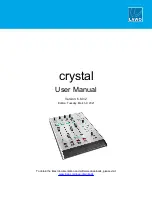
PRESET programs
P4 - WARM-UP
5 250 60 0 3 3
0
B
5
P5 - AEROBIC RESISTANCE
10 250 30 2
2 1 3 B
40
P6 -AEROBIC RESISTANCE
(under USTIM
®
)
20 250 20 3
2 1 3 B
60
P7 - TONIFYING
30 200 6 4
3 2 3 A*
20
P8 - HARDENING
40 250 3 2
0 0 3 A
20
P9 - FORCE + RESISTANCE
50 250 8 4
1 1 8 B
25
P10 - FORCE + RESISTANCE
(under USTIM
®
)
60 250 6 3
1 1 6 B
25
F
Hz
P
μ
s
Work
Rest
Rise
Fall
F
Wave
Total
P11 - FORCE 1(under USTIM® control)
70 250 6 12 0 0 5 B
15
P12 - FORCE 2(under USTIM
®
control)
80 200 4 6
0 0 4 B
15
P13 - FORCE 3(under USTIM
®
control)
90 150 4 10 0 0 3 B
15
63
The stimulation frequency
(also called Pulse Rate)
After defining the wave shape to be
used, a single pulse could also
produce a momentary contraction like
a “wriggle”; however, to obtain a
sustained contraction, we must
supply a pulse train, characterized by
a “frequency”. Frequency (also called
“pulse-rate”) is the repetition rate of
pulses in a second.
The frequency to be used will depend
on the type of fibers to be stimulated.
Any muscle includes slow fibers
characterized by an aerobic
metabolism, and
fast
fibers
characterized by anaerobic
metabolism.
If we want to stimulate
a muscle of which slow fibers are
dominant, we have to use low
frequencies (1 to 30 Hz). On the
other hand, if we want to stimulate
muscles having fast fibers
dominance, we have to use higher
frequencies (50 to 120 Hz.).
8
USTIM - User’s manual Rev. 2(10/19/2012)










































